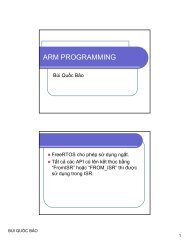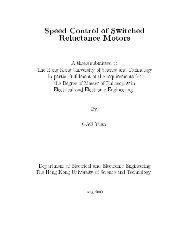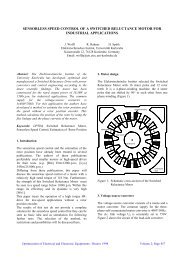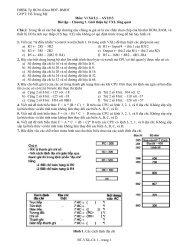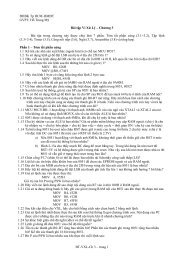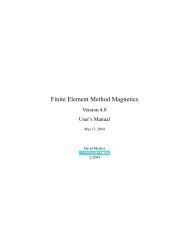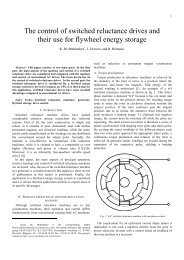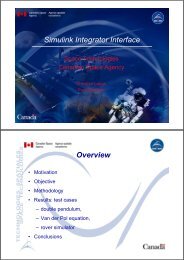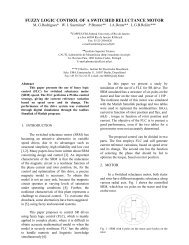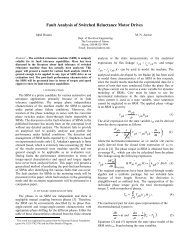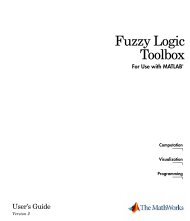System & Program Developments of 8051
System & Program Developments of 8051
System & Program Developments of 8051
Create successful ePaper yourself
Turn your PDF publications into a flip-book with our unique Google optimized e-Paper software.
<strong>System</strong> & <strong>Program</strong><br />
<strong>Developments</strong> <strong>of</strong> <strong>8051</strong><br />
Assembly Language <strong>Program</strong>ming<br />
Assembler Operation<br />
Assembly Language <strong>Program</strong> Format<br />
Assemble-Time Expression Evaluation<br />
Assembler Directives<br />
Assembler Controls<br />
Linker Operation<br />
Linking Relocatable Segments and Modules<br />
Macros<br />
2011/12/7 T. L. Jong, Dept. <strong>of</strong> E.E., NTHU 1
<strong>System</strong> & <strong>Program</strong><br />
<strong>Developments</strong> <strong>of</strong> <strong>8051</strong><br />
<strong>Program</strong> Structure and Design<br />
Introduction<br />
Advantages and Disadvantages <strong>of</strong> Structured<br />
<strong>Program</strong>ming<br />
The Three Structures: statements, loops, choice<br />
Pseudo Code Syntax<br />
Assembly Language <strong>Program</strong>ming<br />
Tools & Techniques for <strong>Program</strong> Development<br />
The Development Cycle<br />
Integration and Verification<br />
Command and Environments<br />
2011/12/7 T. L. Jong, Dept. <strong>of</strong> E.E., NTHU 2
Assembly Language<br />
<strong>Program</strong>ming<br />
PROGRAM.OBJ<br />
PROGRAM.SRC<br />
ASM51<br />
PROGRAM.LST<br />
LIBRARY<br />
FILE1.OBJ<br />
FILE2.OBJ<br />
RL51<br />
PROGRAM.ABS<br />
PROGRAM.MAP<br />
2011/12/7 T. L. Jong, Dept. <strong>of</strong> E.E., NTHU 3
ASM(input_file)<br />
BEGIN<br />
/*assemble source program in input_file)*/<br />
/*pass 1: build the symbol table */<br />
lc = 0; /*lc=location counter; default to 0*/<br />
mnemonic = null;<br />
open input_file;<br />
WHILE<br />
(mnemonic != end) DO BEGIN<br />
get_line(); /*get line from input_file */<br />
scan_line(); /*scan line & get label/symbol & mnemonic */<br />
IF (label) THEN enter_into_symbol_table(label, lc);<br />
CASE mnemonic OF BEGIN<br />
null, comment, END: ; /*do nothing */<br />
ORG:<br />
EQU:<br />
DB:<br />
lc = operand_value;<br />
enter_in_symbol_table( symbol, operand_value);<br />
WHILE (got_operand) DO increment_lc;<br />
/* increment number <strong>of</strong> bytes defined */<br />
lc = lc + operand_value;<br />
DS:<br />
1_byte_instruction: lc = lc + 1;<br />
2_byte_instruction: lc = lc + 2;<br />
3_byte_instruction: lc = lc + 3;<br />
END<br />
END<br />
2011/12/7 T. L. Jong, Dept. <strong>of</strong> E.E., NTHU 4
*pass 2: create the object program*/<br />
rewind_input_file_pointer;<br />
lc = 0;<br />
mnemonic = null;<br />
open_output_file;<br />
WHILE (mnemonic != end) DO BEGIN<br />
get_line();<br />
scan_line(); /* determine mnemonic op code and value(s) <strong>of</strong> operand(s)*/<br />
/*Note: if symbols are used in operand field, their values are looked-up*/<br />
/* in the symbol table created during pass 1 */<br />
CASE mnemonic OF BEGIN<br />
null, comment, EQU, END: ; /*do nothing */<br />
ORG: lc = operand_value;<br />
DB: WHILE (operand) DO BEGIN<br />
put_in_objectfile(operand);<br />
lc = lc + 1;<br />
END /* increment number <strong>of</strong> bytes defined */<br />
2011/12/7 T. L. Jong, Dept. <strong>of</strong> E.E., NTHU 5
DS: lc = lc + operand;<br />
1_byte_instruction: put_in_objectfile(inst_code);<br />
2_byte_instruction: put_in_objectfile(inst_code);<br />
put_in_objectfile(operand);<br />
3_byte_instruction: put_in_objectfile(inst_code);<br />
put_in_objectfile(operand high-byte);<br />
put_in_objectfile(operand low-byte);<br />
lc = lc + size_<strong>of</strong>_instruction;<br />
END<br />
END<br />
END<br />
close_input_file;<br />
close_output_file;<br />
2011/12/7 T. L. Jong, Dept. <strong>of</strong> E.E., NTHU 6
Assembly Language<br />
<strong>Program</strong> Format<br />
Assembly language program contains:<br />
Machine instructions (ANL, MOV)<br />
Assembler directives (ORG,..)<br />
Assembler controls ($TITLE)<br />
Comments<br />
Lines <strong>of</strong> machine instructions or<br />
assembler directives:<br />
[label:] Mnemonic [operand] [,operand] […] [;comment]<br />
2011/12/7 T. L. Jong, Dept. <strong>of</strong> E.E., NTHU 7
Assembly Language<br />
<strong>Program</strong> Format<br />
Label & symbol<br />
PAR EQU 500 ;PAR is a symbol<br />
; which represents the<br />
; value 500<br />
START: MOV A,#0FFH ;START is a label<br />
;which represents the<br />
;address <strong>of</strong> the MOV<br />
;instruction<br />
Special Assembler Symbols<br />
A, R0-R7, DPTR, PC, C, AB, $<br />
2011/12/7 T. L. Jong, Dept. <strong>of</strong> E.E., NTHU 8
Assemble-Time Expression<br />
Evaluation<br />
MOV A,#10 + 10H (MOV A,#1AH)<br />
MOV A,#25 MOD 7 (MOV A,#4)<br />
MOV A,#’9’ AND 0FH (MOV A,#9)<br />
THREE EQU 3<br />
Minus_three EQU -3<br />
MOV A,#(NOT THREE)+1<br />
MOV A,#Minus_three<br />
MOV A,#11111101B<br />
MOV A,#8 SHL 1 (MOV A,#10H)<br />
MOV A,#HIGH 1234H (MOV A,12H)<br />
2011/12/7 T. L. Jong, Dept. <strong>of</strong> E.E., NTHU 9
Assemble-Time Expression<br />
Evaluation<br />
Relational operators: result is always false<br />
(0000H) or true (FFFFH)<br />
EQ = equal<br />
NE not equal<br />
LT < less than<br />
LE greater than<br />
GE >= greater than or equal to<br />
MOV A,#5 = 5<br />
MOV A,#’X’ LT ‘Z’<br />
MOV A,#5 NE 4<br />
MOV A,#’X’ >= ‘X’<br />
MOV A,#$ > 0<br />
2011/12/7 T. L. Jong, Dept. <strong>of</strong> E.E., NTHU 10
Assemble-Time Expression<br />
Evaluation<br />
Expression Examples:<br />
‘B’ - ‘A’ 0001H ‘A’ SHL 8 4100H<br />
8/3 0002H LOW 65535 00FFH<br />
155 MOD 2 0001H (8 + 1)*2 0012H<br />
4*4 0010H 5 EQ 4 0000H<br />
8 AND 7 0000H ‘A’ LT ‘B’ FFFFH<br />
NOT 1 FFFEH 3
Assemble-Time Expression<br />
Evaluation<br />
Operator Precedence<br />
( )<br />
HIGH LOW<br />
* / MOD SHL SHR<br />
+ -<br />
EQ NE LT LE GT GE = < >=<br />
NOT<br />
AND<br />
OR XOR<br />
When same precedence, operators are evaluated<br />
left-to-right<br />
HIGH (‘A’ SHL 8)<br />
HIGH ‘A’ SHL 8<br />
NOT ‘A’ - 1<br />
‘A’ OR ‘A’ SHL 8<br />
0041H<br />
0000H<br />
FFBFH<br />
4141H<br />
2011/12/7 T. L. Jong, Dept. <strong>of</strong> E.E., NTHU 12
Assembler Directives<br />
Assembler state control (ORG, END, USING)<br />
Symbol definition (SEGMENT, EQU, SET,<br />
DATA, IDATA, XDATA, BIT, CODE)<br />
Storage initialization/reservation (DS, DB,<br />
DW, DBIT)<br />
<strong>Program</strong> linkage (PUBLIC, EXTRN, NAME)<br />
Segment selection (RSEG, CSEG, DSEG,<br />
ISEG, BSEG, XSEG)<br />
2011/12/7 T. L. Jong, Dept. <strong>of</strong> E.E., NTHU 13
Assembler State Controls<br />
ORG, END, USING<br />
ORG<br />
100H<br />
ORG ($ + 1000H) AND 0F000H ;set to next<br />
END<br />
;4k boundary<br />
;should be the last statement in the source file<br />
USING expression ;inform ASM51 <strong>of</strong> the currently<br />
;active register bank<br />
MOV PSW,#00011000B ;select RB 3, the only way<br />
USING 3 ;use register bank 3<br />
PUSH AR7 ;1FH (R7 in bank 3)<br />
MOV<br />
USING 1<br />
PSW,#00001000B<br />
PUSH AR7 ;0FH<br />
;to switch register banks<br />
2011/12/7 T. L. Jong, Dept. <strong>of</strong> E.E., NTHU 14
Symbol Definition<br />
The symbol definition directive creates<br />
symbols representing segments,<br />
registers, numbers, & addresses.<br />
2011/12/7 T. L. Jong, Dept. <strong>of</strong> E.E., NTHU 15
Symbol Definition<br />
Segment (CODE, XDATA, DATA,IDATA,BIT)<br />
symbol SEGMENT segment_type<br />
CODE (code segment)<br />
DATA (the internal data space accessible by direct<br />
addressing 00-7FH)<br />
IDATA (the entire internal data space accessible by<br />
indirect addressing, 00-7FH on <strong>8051</strong>, 00-FFH on<br />
8052)<br />
XDATA (the external data space)<br />
BIT (the bit space; overlapping byte locations 20H-<br />
2FH <strong>of</strong> the internal data space)<br />
EPROM SEGMENT CODE (declares that EPROM is<br />
a code segment. To actually begin using this<br />
segment, the RSEG directive is used)<br />
2011/12/7 T. L. Jong, Dept. <strong>of</strong> E.E., NTHU 16
Symbol Definition<br />
EQU and SET -- numbers<br />
symbol EQU expression (assigns a numeric<br />
value to a specific symbol name)<br />
N27 EQU 27<br />
HERE EQU $<br />
MESSAGE: DB ‘This is a message’<br />
LENGTH EQU $-MESSAGE<br />
symbol SET expression (similar to EQU except<br />
that symbol can be redefined<br />
later using another SET directive)<br />
2011/12/7 T. L. Jong, Dept. <strong>of</strong> E.E., NTHU 17
Symbol Definition<br />
DATA, IDATA, XDATA, BIT, & CODE: assign<br />
addresses <strong>of</strong> the corresponding segment<br />
type to a symbol.<br />
e.g.,<br />
FLAG1 EQU 05H<br />
FLAG2 BIT 05H<br />
SETB FLAG1<br />
SETB FLAG2<br />
MOV FLAG1,#0<br />
MOV FLAG2,#0<br />
(error message: data segment address expected)<br />
2011/12/7 T. L. Jong, Dept. <strong>of</strong> E.E., NTHU 18
Storage<br />
Initialization/Reservation<br />
DS (define storage)<br />
[label:] DS expression (reserves spaces in byte units,<br />
can be used in any segment type<br />
except BIT)<br />
DSEG AT 30H ;put in data segment<br />
;(absolute , internal)<br />
LENGTH EQU 40<br />
BUFFER: DS LENGTH ;reserve 40 bytes<br />
MOV R7,#LENGTH<br />
MOV R0,#BUFFER ;R0=30H<br />
LOOP: MOV @R0,#0<br />
INC R0<br />
DJNZ R7,LOOP<br />
2011/12/7 T. L. Jong, Dept. <strong>of</strong> E.E., NTHU 19
Storage<br />
Initialization/Reservation<br />
Create 1000 bytes in external RAM at 4000H<br />
XSTART EQU 4000H<br />
XLENGTH EQU 1000<br />
XSEG AT XSTART ;put I data segment<br />
;(absolute , internal)<br />
XBUFFER: DS XLENGTH ;reserve 40 bytes<br />
MOV DPTR,#XBUFFER<br />
LOOP: CLR A<br />
MOV @DPTR,A<br />
INC DPTR<br />
MOV A,DPL<br />
CJNE A,#LOW(XBUFFER + XLENGTH + 1),LOOP<br />
MOV A,DPH<br />
CJNE A,#HIGH(XBUFFER + XLENGTH + 1),LOOP<br />
(continue)<br />
2011/12/7 T. L. Jong, Dept. <strong>of</strong> E.E., NTHU 20
Storage Initialization/Reservation<br />
DBIT: reserve space in bit units<br />
[label:] DBIT expression<br />
BSEG ;bit segment, absolute (00H-7FH)<br />
KBFLAG: DBIT 1 ;keyboard status<br />
PRFLAG: DBIT 1 ;printer status<br />
DKFLAG: DBIT 1 ;disk status<br />
DB (define byte): initialize code memory w bye values<br />
[label:] DB expression [,expression] […]<br />
CSEG AT 0100H<br />
SQUARES:DB 0,1,4,9,16,25 ;squares <strong>of</strong> number 0-5<br />
MESSAGE:DB ‘Login:’,0 ;null-terminated char string<br />
DW (define word)<br />
[label:] DW expression [,expression] […]<br />
CSEG AT 0200H<br />
DW $,’A’,1234H,2,’BC’ ;02 00 00 41 12 34 00<br />
;02 42 43<br />
2011/12/7 T. L. Jong, Dept. <strong>of</strong> E.E., NTHU 21
<strong>Program</strong> Linkage<br />
Allows separately assembled modules (files)<br />
to communicate by permitting intermodule<br />
referencing and naming <strong>of</strong> the modules<br />
PUBLIC (declare public for other modules to reference)<br />
PUBLIC symbol [,symbol] […]<br />
allows the list <strong>of</strong> specified symbols to be known and used<br />
outside the currently assembled module.<br />
EXTRN (declare symbols defined outside current module)<br />
EXTRN symbol [,symbol] […]<br />
MAIN.SRC<br />
EXTRN<br />
…<br />
CALL<br />
…<br />
CALL<br />
…<br />
END<br />
CODE(HELLO,GOOD_BYE)<br />
HELLO<br />
GOOD_BYE<br />
MESSAGE.SRC<br />
PUBLIC HELLO,GOOD_BYE<br />
…<br />
HELLO: (begin sub)<br />
...<br />
RET<br />
GOOD_BYE: (begin sub)<br />
…<br />
RET<br />
2011/12/7 T. L. Jong, Dept. <strong>of</strong> E.E., NTHU 22
Segment Selection<br />
RSEG (selecting relocatable segment)<br />
RSEG segment_name<br />
segment_name is previously defined by SEGMENT<br />
directive.<br />
Selecting Absolute Segments<br />
CSEG [AT address]<br />
DSEG [AT address]<br />
ISEG [AT address]<br />
BSEG [AT address]<br />
XSEG [AT address]<br />
Each segment has its own location<br />
counter which is set to 0 initially<br />
2011/12/7 T. L. Jong, Dept. <strong>of</strong> E.E., NTHU 23
Segment Selection<br />
LOC OBJ LINE SOURCE<br />
1 ONCHIP SEGMENT DATA<br />
2 EPROM SEGMENT CODE<br />
3<br />
---- 4 BSEG AT 70H ;begin abs bit seg<br />
0070 5 FLAG1: DBIT 1<br />
0071 6 FLAG2 DBIT 1<br />
7<br />
---- 8 RSEG ONCHIP ;begin relocatable data seg<br />
0000 9 TOTAL: DS 1<br />
0001 10 COUNT: DS 1<br />
0002 11 SUM16: DS 2<br />
12<br />
---- 13 RSEG EPROM ;begin relocatable code seg<br />
0000 750000 F 14 BEGIN: MOV TOTAL,#0<br />
15 (continue program)<br />
16 END<br />
2011/12/7 T. L. Jong, Dept. <strong>of</strong> E.E., NTHU 24
Assembler Controls<br />
Establish the format <strong>of</strong> the listing and<br />
object files. Controls the look <strong>of</strong> listing file,<br />
without having any effect on the program.<br />
Can be entered on the invocation line or<br />
placed in the source program (preceded<br />
with $)<br />
Primary controls and general controls<br />
e.g., DATE, INCLUDE, LIST, MACRO(50),<br />
XREF<br />
2011/12/7 T. L. Jong, Dept. <strong>of</strong> E.E., NTHU 25
Assembler Controls<br />
NAME<br />
Primary/<br />
General<br />
DEFAULT<br />
Abbrev<br />
.<br />
Meaning<br />
DATE(date) P DATA() DA Places string in header (9 Char.<br />
max.)<br />
DEBUG P NODEBUG DB Outputs debug symbol information<br />
to object file<br />
NODEBUG P NODEBUG NODB Symbol information not placed in<br />
object file<br />
EJECT G Not applicable EJ Continue listing on next page<br />
ERRORPRINT P NOERRORPRINT EP Designates a file to receive error<br />
Messages in addition to the listing<br />
file (defaults to console)<br />
NOERRORPRINT P NOERRORPRINT NOEP Designates that error messages<br />
will be printed in listing file only<br />
GEN P GENONLY GO List only the fully expanded source<br />
as if all lines generated by a macro<br />
call were already in the source file<br />
2011/12/7 T. L. Jong, Dept. <strong>of</strong> E.E., NTHU 26
Assembler Controls<br />
GENONLY G GENONLY NOGE List only the original source<br />
text in the listing file<br />
INCLUDE(file) G Not applicable IC Designates a file to be<br />
included as part <strong>of</strong> the<br />
program<br />
LIST G NOLIST LI Print subsequent lines <strong>of</strong><br />
source code in listing file<br />
NOLIST G NOLIST NOLI Do not print subsequent lines<br />
<strong>of</strong> source code in listing<br />
file<br />
MACRO(mem_percent<br />
)<br />
P MACRO(50) MR Evaluate and expand all macro<br />
calls. Allocate percentage <strong>of</strong><br />
free memory for macro<br />
processing<br />
NOMACRO P MACRO(50) NOMR Do not evaluate macro calls<br />
MOD51 P MOD51 MO Recognize the <strong>8051</strong>-specific<br />
predefined special function<br />
registers<br />
NOMOD51 P MOD51 NOMO Do not recognize <strong>8051</strong>-<br />
specific predefined special<br />
function registers<br />
2011/12/7 T. L. Jong, Dept. <strong>of</strong> E.E., NTHU 27
Assembler Controls<br />
OBJECT(file) P OBJECT(source.O<br />
BJ)<br />
NOOBJECT P OBJECT(source.O<br />
BJ)<br />
OJ<br />
NOOJ<br />
Designates file to receive object<br />
code<br />
Designates that no object<br />
file will be created<br />
PAGING P PAGING PI Designates that listing file<br />
be broken into pages and each<br />
will have a header<br />
NOPAGING P PAGING NOPI Designates that listing file will<br />
contain no page breaks<br />
PAGELENGTH P PAGELENGTH(60) PL Sets maximum number <strong>of</strong> lines in<br />
each page <strong>of</strong> listing file (range = 10<br />
to 65,536)<br />
PAGEWIDTH P PAGEWIDTH(120) PW Sets maximum number <strong>of</strong><br />
characters in each line <strong>of</strong> listing file<br />
(range = 72 to 132)<br />
PRINT(file) P PRINT(source.LST) PR Designates file to receive source<br />
listing<br />
NOPRINT P PRINT(source.LST) NOPR Designates that no listing file will be<br />
created<br />
2011/12/7 T. L. Jong, Dept. <strong>of</strong> E.E., NTHU 28
Assembler Controls<br />
SAVE G Not applicable SA Stores current control settings from<br />
SAVE stack<br />
RESTORE G Not applicable RS Restores control settings<br />
from SAVE stack<br />
REGISTERBANK(rb,..) P REGISTERBANK(0) RB Indicates one or more banks<br />
used in program module<br />
NOREGISTERBANK P REGISTERBANK(0) NORB Indicates that no register banks are<br />
used<br />
SYMBOLS P SYMBOLS SB Creates a formatted table <strong>of</strong> all<br />
symbols used in program<br />
NOSYMBOLS P SYMBOLS NOSB Designates that no symbol table is<br />
created<br />
TITLE(string) G TITLE() TT Places a string in all subsequent<br />
page headers (max. 60 characters)<br />
WORKFILES(path) P Same as source WF Designates alternate path for<br />
temporary workfiles<br />
2011/12/7 T. L. Jong, Dept. <strong>of</strong> E.E., NTHU 29
Assembler Controls<br />
XREF P NOXREF XR Creates a cross reference listing <strong>of</strong><br />
all symbols used in program<br />
NOXREF P NOXREF NOXR Designates that no cross<br />
reference list is created<br />
2011/12/7 T. L. Jong, Dept. <strong>of</strong> E.E., NTHU 30
Linker Operations<br />
Intel RL51: links modules into an output<br />
file:<br />
RL51 input_list [TO output_file] [location_controls]<br />
input_list: a list <strong>of</strong> relocatable object modules (files)<br />
separated by commas.<br />
Output_file: the name <strong>of</strong> the output absolute object<br />
module (executable program).<br />
Location controls: set start addresses for the named<br />
segments.<br />
e.g., RL51 MAIN.OBJ,MESSAGE.OBJ,<br />
SUBROUTINE.OBJ TO EXAMPLE &<br />
CODE (EPROM(4000H))<br />
DATA(ONCHIP(30H))<br />
2011/12/7 T. L. Jong, Dept. <strong>of</strong> E.E., NTHU 31
Linker Operations<br />
2011/12/7 T. L. Jong, Dept. <strong>of</strong> E.E., NTHU 32
Annotated Example: ECHO.LST<br />
2011/12/7 T. L. Jong, Dept. <strong>of</strong> E.E., NTHU 33
Annotated Example: ECHO.LST<br />
2011/12/7 T. L. Jong, Dept. <strong>of</strong> E.E., NTHU 34
Annotated Example: IO.LST<br />
2011/12/7 T. L. Jong, Dept. <strong>of</strong> E.E., NTHU 35
Annotated Example<br />
2011/12/7 T. L. Jong, Dept. <strong>of</strong> E.E., NTHU 36
Annotated Example<br />
2011/12/7 T. L. Jong, Dept. <strong>of</strong> E.E., NTHU 37
Annotated Example<br />
2011/12/7 T. L. Jong, Dept. <strong>of</strong> E.E., NTHU 38
Annotated Example: ECHO+IO<br />
2011/12/7 T. L. Jong, Dept. <strong>of</strong> E.E., NTHU 39
2011/12/7 T. L. Jong, Dept. <strong>of</strong> E.E., NTHU 40
MACROS<br />
Macro allows frequently used sections <strong>of</strong><br />
code to be defined once using a simple<br />
mnemonic and used anywhere in the<br />
program by inserting the mnemonic.<br />
ASM51’s MPL: string replacement.<br />
%DEFINE (call_pattern) (macro_body)<br />
%DEFINE (PUSH_DPTR)<br />
(PUSH DPH<br />
PUSH DPL)<br />
%PUSH_DPTR will be replaced by PUSH<br />
DPH and PUSH DPL two instructions in<br />
the .LST file<br />
2011/12/7 T. L. Jong, Dept. <strong>of</strong> E.E., NTHU 41
Advantages <strong>of</strong> Using Macros<br />
More readable<br />
The source program is shorter and<br />
requires less typing<br />
Using macros reduces bugs<br />
Using macros frees the programmer<br />
from dealing with low-level details<br />
2011/12/7 T. L. Jong, Dept. <strong>of</strong> E.E., NTHU 42
Parameter Passing<br />
%DEFINE<br />
(macro_name(parameter_list))<br />
(macro_body)<br />
%DEFINE (CMPA# (VALUE))<br />
(CJNE A,#%VALUE, $ + 3<br />
)<br />
%CMPA# (20H) = CJNE A,#20H,$+3<br />
2011/12/7 T. L. Jong, Dept. <strong>of</strong> E.E., NTHU 43
Parameter Passing<br />
JUMP if A is greater than X:<br />
%DEFINE (macro_name(parameter_list))<br />
(macro_body)<br />
%DEFINE (JGT(VALUE,LABEL))<br />
(CJNE A,#%VALUE+1, $ + 3 ;<br />
)<br />
JNC %LABEL ;JGT<br />
%JGT(‘Z’,GREATER_THAN)<br />
2011/12/7 T. L. Jong, Dept. <strong>of</strong> E.E., NTHU 44
Local Labels<br />
%DEFINE (macro_name [(parameter_list)])<br />
[LOCAL list_<strong>of</strong>_local_labels]<br />
(macro_body)<br />
%DEFINE (DEC_DPTR) LOCAL SKIP<br />
(DEC DPL<br />
%SKIP: )<br />
MOV A,DPL<br />
CJNE A,#0FFH,%SKIP<br />
DEC DPH<br />
2011/12/7 T. L. Jong, Dept. <strong>of</strong> E.E., NTHU 45
%DEC_DPTR =<br />
<br />
Local Labels<br />
DEC DPL<br />
MOV A,DPL<br />
CJNE A,#0FFH, SKIP00<br />
DEC DPH<br />
SKIP00:<br />
Side effect: A is used and changed<br />
2011/12/7 T. L. Jong, Dept. <strong>of</strong> E.E., NTHU 46
Preserve A by Push-Pop<br />
%DEFINE (DEC_DPTR) LOCAL SKIP<br />
(PUSH A<br />
DEC DPL<br />
MOV A,DPL<br />
CJNE A,#0FFH,%SKIP<br />
DEC DPH<br />
%SKIP: POP A<br />
)<br />
2011/12/7 T. L. Jong, Dept. <strong>of</strong> E.E., NTHU 47
Repeat Operations-- Built-in<br />
Macros<br />
%REPEAT (expression) (text)<br />
%REPEAT (100)<br />
(NOP<br />
)<br />
2011/12/7 T. L. Jong, Dept. <strong>of</strong> E.E., NTHU 48
Control Flow Operations<br />
Conditional Assembly in ASM51:<br />
%IF (expression) THEN (balanced_text)<br />
[ELSE (balanced_text)]<br />
INTERNAL EQU 1 ;1=<strong>8051</strong> serial I/O drivers<br />
. ;0=8251 serial I/O drivers<br />
%IF (INTERNAL) THEN<br />
(INCHAR: . ;<strong>8051</strong> driver<br />
.<br />
OUTCHR: .<br />
.<br />
) ELSE<br />
(INCHAR: . ;8251 driver<br />
.<br />
OUTCHR: .<br />
.<br />
)<br />
2011/12/7 T. L. Jong, Dept. <strong>of</strong> E.E., NTHU 49





